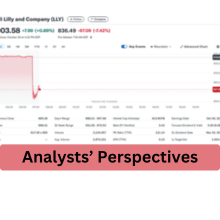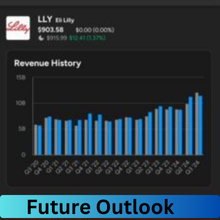
- Eli Lilly’s third-quarter earnings report, released Wednesday, was a significant moment for investors and market watchers. The pharmaceutical giant’s stock took a sharp dive, dropping as much as 10% in premarket trading. This reaction came after the company missed Wall Street’s revenue expectations, highlighting the challenges it faces despite promising drug pipelines. Let’s dig deeper into the numbers and what they mean for Eli Lilly’s future.
Earnings Summary
In the third quarter, Eli Lilly reported revenue of $11.4 billion, falling short of the projected $12.17 billion. While this was a 20% increase year over year, it wasn’t enough to satisfy analysts. The company also reported profits of $970.3 million, which contributed to the negative sentiment surrounding the earnings call.
Key Highlights
Despite the earnings miss, some areas showed resilience. The sales from Eli Lilly’s two blockbuster drugs, Zepbound and Mounjaro, were noteworthy. Together, they generated $4.4 billion in sales, with Mounjaro alone accounting for $3.1 billion. However, sales from Zepbound did not meet expectations, landing at $1.3 billion against a forecast of $1.7 billion.
The Impact of GLP-1 Drugs
Eli Lilly’s focus on GLP-1 drugs is a central part of its business strategy. These medications, particularly for weight loss and diabetes management, are gaining traction in the market. Yet, the company revealed that U.S. sales were negatively impacted by “inventory decreases in the wholesaler channel.” This detail highlights the complexities of drug distribution and sales dynamics that could influence future earnings.
Analysts’ Perspectives
Market analysts, including Jared Holz from Mizuho, have pointed out that the sales figures could indicate shifting consumer preferences. Holz noted that while sales for Zepbound might eventually outpace projections, Mounjaro could see a slight decline as more patients gravitate toward Zepbound due to its higher dosage weight-loss benefits. This insight emphasizes the evolving landscape of the weight-loss drug market, which investors are closely monitoring.
Challenges Facing Eli Lilly
Eli Lilly’s adjustments to its profit guidance and the high end of its revenue outlook indicate underlying challenges. The reduced sales forecast raises questions about the company’s ability to maintain its growth trajectory, especially as competition intensifies in the pharmaceutical industry. The current inventory issues could pose further hurdles, necessitating strategic shifts to stabilize performance.
Alzheimer’s Drug Developments
Eli Lilly is also advancing in the Alzheimer’s drug space with its candidate, Kisunla. This drug is in late-stage trials and aims to compete with Leqembi from Biogen and Eisai. Recent studies suggest that starting with lower doses could reduce the risk of brain swelling, a concern with many Alzheimer’s treatments. The success of Kisunla could open significant revenue streams for Lilly, adding to the company’s diverse portfolio.
Future Outlook
Looking ahead, Eli Lilly faces a crossroads. The company has made strides in addressing drug shortages and is working on expanding access to its medications. The introduction of a direct-to-consumer platform for cash-paying patients could provide a much-needed boost in accessibility and sales. However, navigating the complexities of the healthcare sector will remain a challenge.
Also read: Channing Tatum’s Last Post with Zoë Kravitz Revealed
Stock Performance Trends
Eli Lilly’s stock has had a rollercoaster ride. Up more than 50% in 2024 prior to this earnings report, the recent dip serves as a stark reminder of the volatility in the pharmaceutical market. Investors are left wondering if the stock has peaked or if it still has room to grow, particularly in light of the increasing focus on weight-loss drugs.
Shortages and Access Issues
Drug shortages remain a critical issue for Eli Lilly, especially for its GLP-1 products, which have seen surging demand. The FDA is reviewing the potential of placing these drugs back on the shortage list. This situation adds another layer of complexity to the company’s operations, emphasizing the need for effective supply chain management. The launch of its direct-to-consumer platform aims to counterbalance these shortages, allowing patients to purchase medications more easily.
Also read: Apple’s Mighty Mac Mini: Performance You Won’t Believe
Conclusion
Eli Lilly’s recent earnings miss has sent ripples through the market, highlighting the pressures the company faces despite its growth potential. With significant revenue coming from its GLP-1 drugs and ongoing developments in Alzheimer’s treatment, the company has both challenges and opportunities ahead. How it navigates these waters will determine its trajectory in the coming months.
FAQs
What caused the stock drop?
The stock drop was primarily due to Eli Lilly’s Q3 earnings miss, which fell short of Wall Street expectations for revenue and profit.
How do GLP-1 drugs impact revenue?
GLP-1 drugs, particularly Zepbound and Mounjaro, are key revenue drivers for Eli Lilly. However, recent sales missed projections, impacting overall revenue.
What is the outlook for Eli Lilly’s Alzheimer’s drug?
Kisunla is in late-stage trials and shows promise. If successful, it could tap into a significant market, enhancing Eli Lilly’s portfolio.
Why did analysts adjust their expectations?
Analysts adjusted expectations based on the mixed performance of Eli Lilly’s key products and the overall market challenges in the healthcare sector.
What are the future growth areas for Eli Lilly?
Future growth areas include expanding sales of GLP-1 drugs, successful development of its Alzheimer’s drug, and addressing supply chain issues to meet demand.

